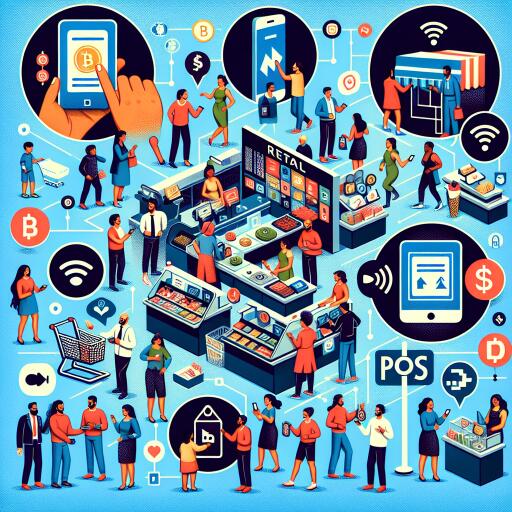Retail: Embracing Digital Wallets, BNPL, and POS Systems
The landscape of retail payments is undergoing a profound transformation, driven by the integration of cutting-edge payment solutions. As we venture deeper into the digital age, the methods by which consumers choose to transact are evolving rapidly. Digital wallets, for instance, are forecasted to reach a transaction value of over US$16 trillion globally by 2028, fundamentally altering consumer spending patterns worldwide.
According to insights from McKinsey & Company, advanced Point of Sale (POS) systems are now incorporating instant payment technologies to offer real-time, frictionless shopping experiences, indicating a significant shift in consumer trust toward large tech enterprises over traditional banking institutions. This shift underscores a growing preference for digital-first payment options, marking a pivotal moment in retail transactions.
The increasing popularity of Buy Now, Pay Later (BNPL) services further exemplifies the movement toward more flexible financial solutions, a trend that has become particularly pronounced during periods of economic uncertainty. Such services, along with innovations in POS technology—including cloud-based systems and enhanced personalization—are set to revolutionize retail interactions and elevate customer satisfaction to new heights.
In the Euro area, the retail payments market has shown strong trends in the first half of 2023, with non-cash payment transactions witnessing a 10.1% increase. This highlights an accelerating shift towards digital payment solutions, exemplified by a 15.6% increase in card-based payments and a significant 24.3% surge in contactless payments, as reported by the European Central Bank.
Olivier Sery, a veteran in digital solutions sales, recently shared insights on the substantial growth of digital wallets, which are anticipated to constitute 28% of all non-cash transactions by 2027. This surge is primarily fueled by the escalating dominance of e-commerce and mobile wallet transactions—expected to account for 54% of transaction values by 2026. Sery underlines the transformation of digital wallets from mere payment tools to comprehensive banking solutions, offering customers broader services and promoting sustainable banking practices.
Moreover, the concept of “super wallets” is emerging, integrating an array of services from credit requests to social media within a single application. This is especially relevant in emerging markets, suggesting a bright future for digital wallets as they become more embedded in daily life.
Pinar Koygun, a retail vertical growth expert, predicts that by 2027, digital wallets will dominate 61% of online transaction value and 46% of in-store transactions, a trend particularly strong in the APAC region due to the prevalence of QR-code payments. A global survey revealed that nearly half of shoppers have utilized digital wallets last year, drawn by their convenience, indicating a paradigm shift across all commerce channels.
The realm of BNPL services is not just reshaping consumer credit but also branching into B2B applications, enhancing traditional trade credit practices with digital solutions. This shift is significantly driven by advancements from tech companies in Europe and the US, evidencing a growing trend toward more structured and secure payment terms in various sectors, including construction.
Louis Carbonnier, co-founder of a pioneering BNPL company, discusses the fluctuating popularity of BNPL services, predicting a future of market consolidation and regulatory reforms. He notes the distinct dynamics of B2B BNPL services, potentially leading to a few dominant players in the sector as it matures.
Adding to the discussion, Sery observes the BNPL sector’s appeal, particularly among younger consumers who favor the simplicity and convenience of digital transactions. He envisions a future where BNPL platforms evolve into “super apps,” significantly enhancing the retail experience by facilitating personalized interactions based on purchasing habits.
Retails are simultaneously revamping their POS systems, integrating innovative technologies to enhance consumer interaction at the point of sale. Technologies like scan-free checkouts and mobile POS systems are pivotal, offering merchants and consumers alike numerous benefits including improved operational efficiency and customer service.
Brad Hyett, a CEO specializing in payment technologies, highlights the transformation brought about by NFC-enabled SoftPoS systems. These systems allow retail staff to use existing devices for payments, improving the shopping experience by reducing wait times and eliminating the need for traditional checkout infrastructures.
Lastly, George Sinanis underscores the significance of Mobile POS systems, which transform any smartphone or tablet into a payment terminal. This marks a considerable shift in retail interactions, offering unmatched convenience and flexibility for transactions anywhere, directly at the point of customer interaction.
As retailers continue to navigate these technological advancements, integrating loyalty programs and real-time data to personalize rewards, the future of retail seems increasingly digital. With these evolutions, retail strategies are ever more aligned with customer preferences, setting the stage for a richer, more engaging shopping experience.
